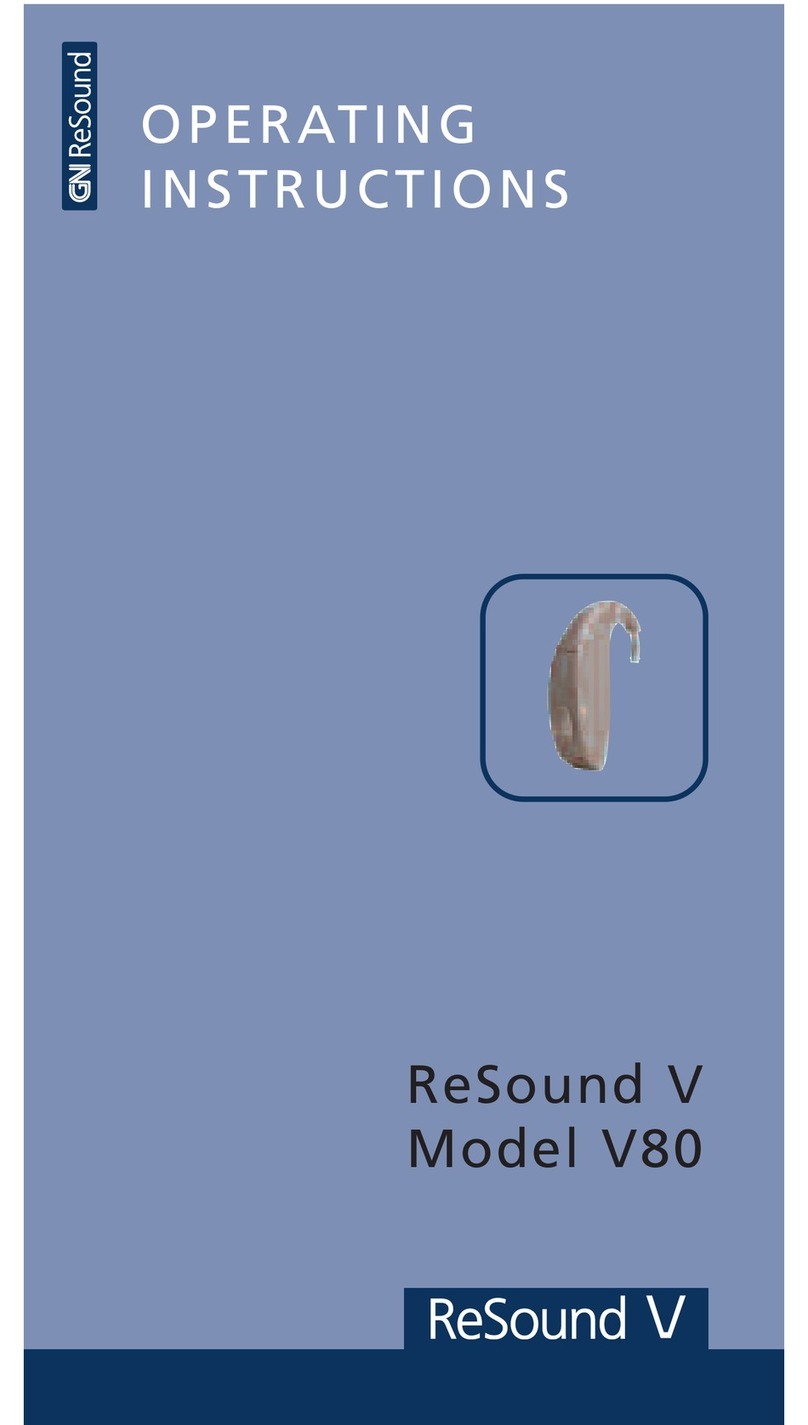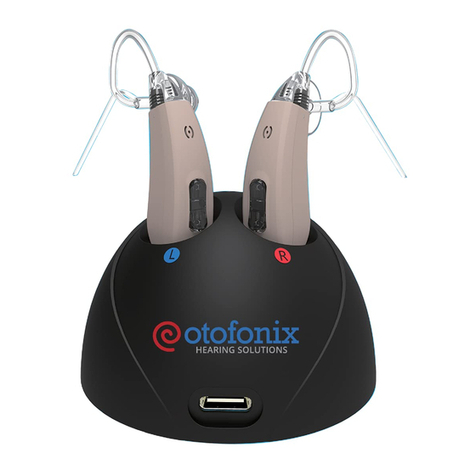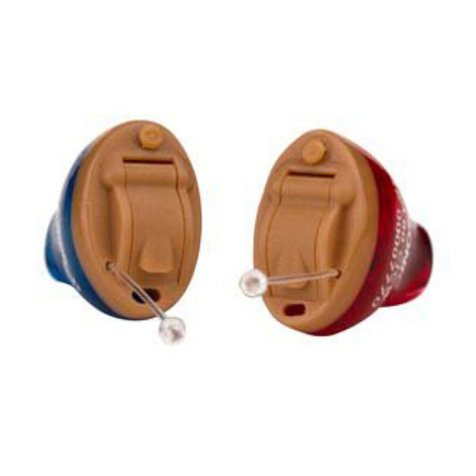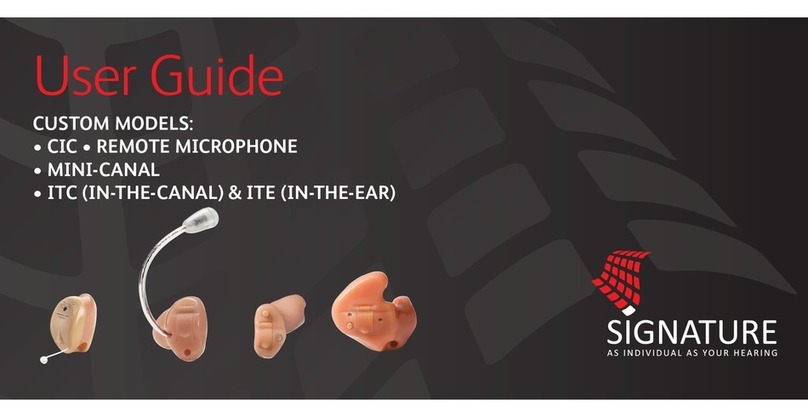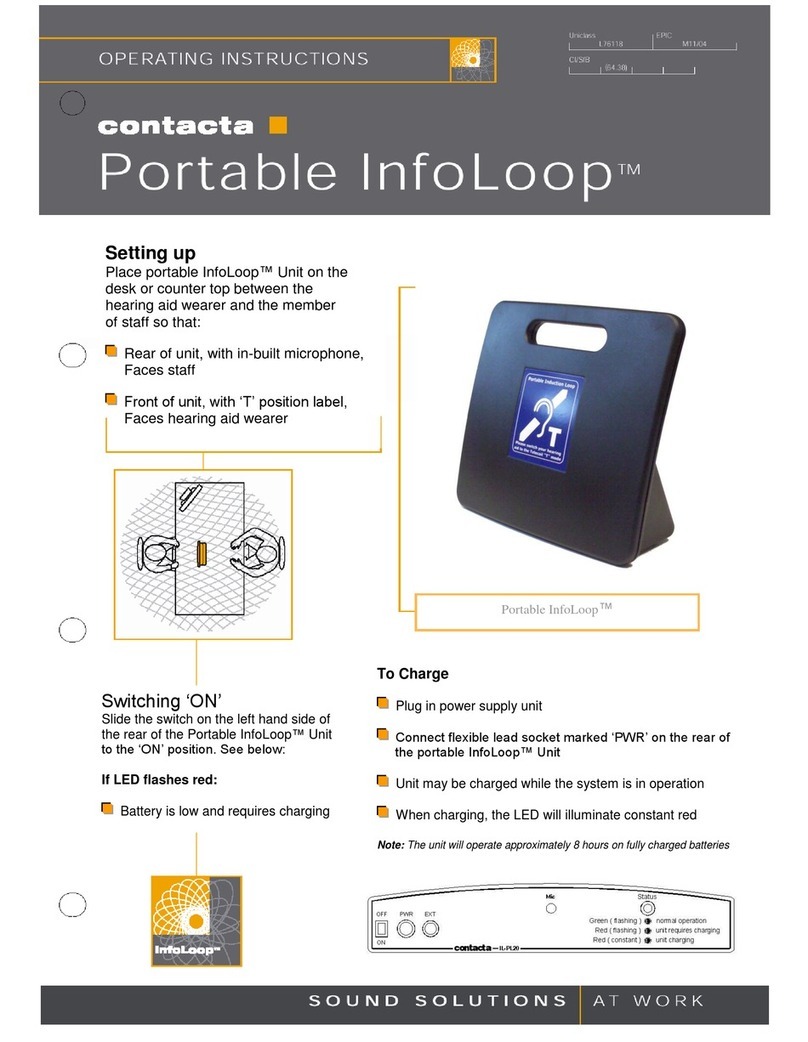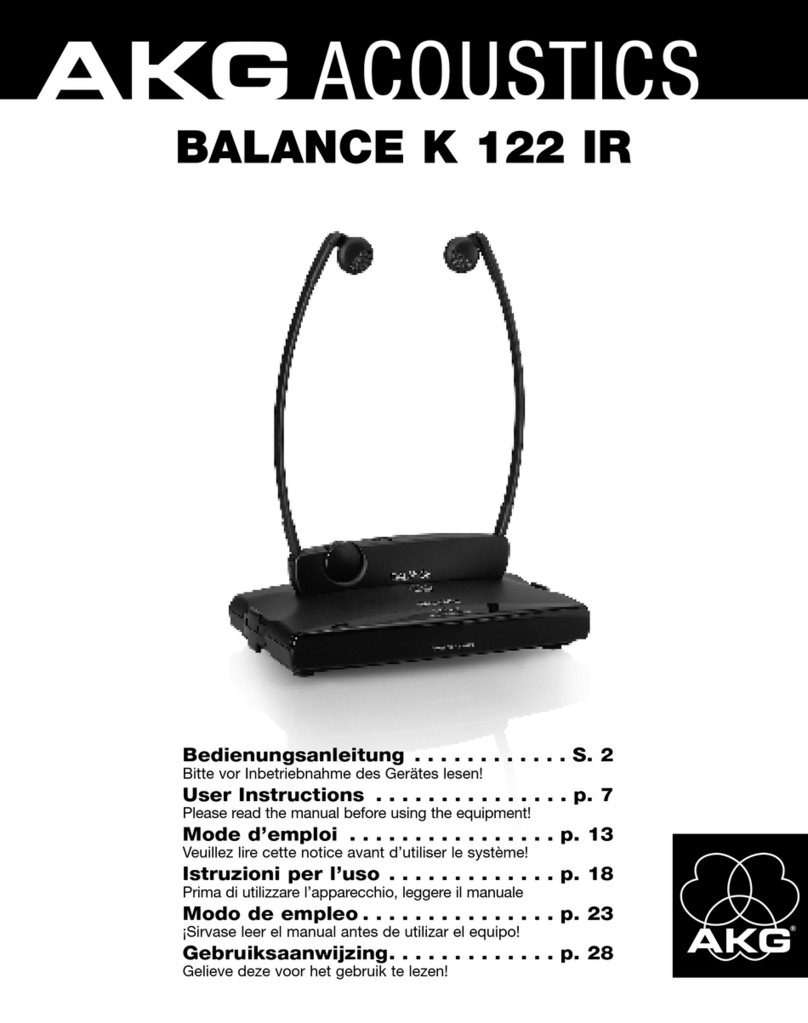MedeScan JH-908 User manual

Instruction Manual Model: JH-908
Please read this user manual thoroughly and
completely before using the product.
HEARING AID
VER: 909G-20220120-V01
1639
Life cycle of product is three years
1300 736 330
www.medescan.com.au
Visit our YouTube channel for our latest easy to follow
instructional videos. Simply search for Medescan on YouTube
and subscribe to our channel for the latest products and
instruction videos.
You can also scan the QR code for instant access.
Designed in Australia
Made in China

-1- -2-
CONTENTS
03
06
07
08
09
10
13
12
11
15
21
22
24
27
29
30
31
32
19
16
I.IMPORTANT SAFETY INSTRUCTIONS
1.CONTRAINDICATION
2.WARNINGS
3.NOTICE
II.DO NOT USE IF ANY OF THE FOLLOWING APPLY TO YOU
III.MATTERS NEEDING ATTENTION, WARNINGS AND TIPS
IV.HOW TO USE YOUR DEVICE
1.QUICK GUIDE
2.HOW TO APPLY DOMES
3.WEARING/REMOVE HEARING AID
4.TURN ON/TURN OFF
5.VOLUME ADJUSTMENT
6.HEARING AID CHARGING
7.HOW TO USE THE CHARGING CASE
8.CLEANING
V. MAINTENANCE AND CLEAN
VII.HEARING AID CARE
VII.TROUBLESHOOTING GUIDE
VIII.TIPS FOR BETTER COMMUNICATIO
IX.TECHNICAL SPECIFICATION
X. ACCESSORIES LIST
XI.NORMALIZED SYMBOLS
XII.MAINTENANCE, STORAGE, AND DISPOSAL
XIII.WARRANTY

-3- -4-
I.IMPORTANT SAFETY INSTRUCTIONS
1. CONTRAINDICATION
The device should not be used in the following situations:
- Patients with chronic suppurative otitis media (CSOM),congenital
ear atresia, or any type of ear discharge
- Anyone under 36 months old
2. WARNINGS
- Keep small parts (hearing instrument, ear domes, battery or other
detachable parts) that can be swallowed out of children’s reach.
Dropping, immersing in liquid, exposure to strong electromagnetic
fields or excessive heat will damage the hearing aids. Remove
devices prior to any type of X-ray, MRI, or CT scan. If parts become
stuck in the ear canal, seek medical assistance - do not attempt to
remove by yourself.
3. Notice
- Do not use at high volume for extended periods of time - ear injury
can result.
- If you experience any pain or strong discomfort using the devices,
remove and consult a doctor.
- Routine maintenance to keep the device clean is required.
Ensure that ear domes are free of debris and moisture at all times.
- Avoid shocks or dropping the product.
- Do not store or use the product in environments of high humidity
or temperature (such as sauna room), to avoid damage.
- Batteries should be properly recycled and not disposed in the
trash.
- Keep the devices away from small children. Injury or damage may
result.
- Do not set volume levels too high. Listening with high-output
devices for extended periods at high volume levels can cause
further hearing damage.
- Do not share your hearing aids with others. Using a hearing aid
configured for someone else can result in hearing damage or injury.
- Monitor for any unusual skin reaction. If you notice any allergic
reaction (itchiness, swelling, or rash), stop wearing the hearing
aids and consult a medical specialist.
- Do not touch the hearing aids to any type magnet or magnetized
object. Your hearing aids are delicate electronic instruments and
may be damaged by contact with strong magnetic fields.
- Do not attempt to open or repair the devices yourself. Damage
can result and will void the warranty.
- Do not store your devices in a hot/humid locations. You should
Warning
Read all the information in this instruction manual and any other
literature included in the box before using the device.
Warning

-5-
II. DO NOT USE IF ANY OF THE FOLLOWING APPLY
TO YOU:
never leave your hearing aids near heating appliances or in direct
sunlight.
- Do not leave your hearing aids in the car as inside temperatures
can reach dangerous levels which could damage the devices.
- Do not use the hearing aids together with a cell phone earpiece
directly - excessive noise and distortion may result. Instead, use
via Bluetooth pairing with your cell phone. Radio wave emissions
from mobile phones can cause noise in the hearing aids or result in
reduced volume.
- Please contact the MANUFACTURER:
• For assistance, if needed, in setting up, using or maintaining
your devices or
• To report any unexpected operation or events
1) Congenital atresia of external ear or deformity of any part of the
ear canal
2) Deafness is unstable, and the degree of hearing loss often
fluctuates
3) Persistent headaches, dizziness, earaches, tinnitus or other
symptoms that are not suitable for adaptation
4) Sudden onset of hearing loss within the past 3 months; rapid
progressive deafness; unilateral hearing loss or other acute ear
disease;
5) Effusion (secretions/discharge) in the ear and/or frequent
purulence (pus)
6) Central deafness (central nervous system) or non-organic
deafness
7) Patients with acute otitis externa and tympanitis
8) Patients with acute and chronic suppurative otitis media (in the
period of purulent infection)
9) Patients who are allergic to the materials of this product
Specific warnings / statements
Keep small parts away from and out of children´s reach to avoid
accidental ingestion
Warning not to use in explosive or oxygen-enriched atmospheres, as
doing so may damage the device
Warning that it should only be used by intended person as using
hearing aids designed for someone else may result in hearing
damage
-6-

1. Do not immerse the hearing aid in any liquid. Remove the
hearing aid before swimming or bathing. After swimming or
washing, wait for the ear canal to dry before wearing the hearing
aid.
2. After removing the hearing aid at night, it should be placed in a
case with a desiccant if possible, protected from light, high
temperature and high humidity environment.
3. The external surfaces of the hearing aid should be kept clean,
and earwax in the ear domes should be cleaned out daily
4. Applicable objects: Suitable for people with air-conducting
hearing loss of about 30-50dB
5. When you do not use hearing aids, please charge the product
regularly to avoid battery damage; the recommended charging
time interval of hearing aids is ≤28 days
-7- -8-
III. Matters needing attention, warnings and tips IV.HOW TO USE YOUR DEVICE
1. Microphone
2. Multi-function Button
(ON/OFF, Volume Control)
3. Ear Dome
4. Charging Contacts
1
2
4
3

-9- -10-
1.【QUICK GUIDE】2.【HOW TO APPLY DOMES】Step 2: Hold on to the end of the hearing aid and push firmly to
ensure that the dome is fastened securely.
Notes:
After the ear dome is installed, pull the ear dome gently to see if it
is firmly installed and ensure the ear dome does not fall off easily.
L M S
Please follow these steps to mount domes, because Incorrect
dome replacement could result in the dome being left in the ear
when you remove the hearing aid.
Step 1: Choose a suitable size ear dome.
1.Charging your hearing aids
* Before using your hearing aid for the first time, it is recommended
to charging when it light in green and the green light turn off
indicates charging is complete.
2.Turn ON/OFF
Long press the “Multi-function button” for three (3) seconds to Turn
it ON/OFF
3.Volume Adjustment
Short press “Multi-function button” to increase or decrease the
volume
1 2
Multi-function Button
(ON/OFF,Volume Control)

-11- -12-
3.【WEARING/REMOVE HEARING AID】4.【TURN ON/TURN OFF】3.1 Wearing hearing aid
Step 1: Hold the hearing aid body (hard part), place in the ear
(Make sure it is in right direction like picture).
Step 2: Move the body slightly into auricle for holding.
3.2 Removing the hearing aid
Step 1: Grasp the protruding hearing aid and remove it.
Notes: For comfort, always turn off your hearing aids before you
wear or remove them.
Turn On: Long press the “Multi-function button” for three (3)
seconds and the hearing aid will be power ON with the prompt tone
of " Beep ".
Turn Off: Long press the “Multi-function button” for three (3)
seconds and the hearing aid will be power OFF with the prompt
tone of " Beep ".
*Note:
1.It may be in few circumstances that the ear dome remain
attached to the auditory meatus after the hearing aid is taken out.
In that case, please ask a professional doctor to take the ear dome
out.
2. Before the hearing aid is appropriately secured, it may give out
the creak sound, which is a normal phenomenon. The creak sound
can be used as a reference to determine whether the hearing aid is
secured. If the hearing aid gives out squeaking, please check if it is
taken on correctly; if so, but the squeaking remains, please replace
with the other set of ear dome. When the hearing aid is not in use,
please turn it off without delay.
3. When the hearing aid is not functioning properly, please check
the “Troubleshooting Guide”. If none of the solutions work, please
contact our after-sales service team.
12

-13- -14-
5.【VOLUME ADJUSTMENT】The hearing aid has 6 volume levels.
5.1 Short press “Multi-function button” to increase or decrease the
volume.(Short Press once)
5.2 When the volume is the highest, one additional pressing on the
key will reset the volume to the lowest level, so on and so forth. The
hearing aid can automatically record the previously tuned volume
level.
Note: You will hear a "Beep" when you turn the volume up or down.,
and when the volume is adjusted to highest level, it will give out the
prompt tone of "Beep-Beep".
The hearing aid can’t automatically record the previously tuned
volume level when the hearing aid is Low Power.
Multi-function button
(ON/OFF,Volume Control)
Micro USB Cable
1. Lip
2. Hearing aid charging indicator
3. Charging case charging indicator
4. Hearing aid charging contacts pin
5. Hearing aid charging insert
6. Micro USB connection to external power supply
1
2
3
4
56

6.【HEARING AID CHARGING】7.【HOW TO USE THE CHARGING CASE】-15- -16-
Hearing aid charging:
Put the hearing aid back into the correct slot of the charging case,
they will automatically charging . (Please make sure that the
hearing aid is in turn-off state when charging.) Orange light will
indicate hearing aids are charging. After fully charged, they will
light in green and the green light turn off indicates charging is
complete.
(See details in table for Charging Indicator Changes of the
Charging Case)
7.1. Please make sure that the hearing aid is in power-off state
when charging. Plug the small Micro-USB cable tip into the USB
charging port of the Case. Plug the large USB-A end into a USB-A
power source such as a wall charger or your computer, close the lid
and place it steadily.
7.2 The indicator light will show the charging status of the battery
until the hearing aid is fully charged. When the case is charging,
the indicator shows a orange solid light, and fully charged the
indicator light will shows a solid green light will be constant and the
light turning off indicates charging is complete.
Correct
Charging Fully Charged
Wrong

-17- -18-
7.3 With the hearing aids in the case, all charging will automatically
turn off when the case and hearing aids are fully charged. The case
will continue charging with or without the case lid closed but it is
recommended to close the lid when charging overnight to keep out
dust and moisture.
7.4 The charging process will automatically stop when the case
and hearing aids are fully charged, so the hearing aids can be
safely left in the charger. Place it on a flat even surface away from
exposure to moisture, dust, or extreme temperatures.
*Note: The fully charged case offers 3 full charging cycles for a pair
of hearing aids.
*Note:
1.Charging Case Low Power: The charging case indicator will
change orange when the charging case battery drops below 10%,
please charge the case.
2.When the case is fully charged, the indicator will show a solid
green light will be constant and the light turn off indicates charging
is complete.
3.When the hearing aid and case is not functioning properly, please
check the “ Troubleshooting Guide”. If none of the solutions work,
please contact our after-sales service team.
Charging Indicator Changes of the Charging Case
Flashing
Flash
Solid Orange Light
Solid Green Light
Hearing aid
Charging
(Charging
Case is not
charging)
Charging
Case
Charging
100%
10-99%
100%
0-99%
0-10%
Charging state
Hearing aid
charging
indicator
Charging
indicator of
the charging case
Charging Fully Charged

8.【CLEANING】-19- -20-
All data in this manual, such as service time, charging time,
continuous working time, and charging times are derived from our
internal laboratory testing and meant for reference purposes only.
Your exact usage and times may differ depending on various
conditions and use patterns. It is a normal phenomenon to hear
some high-pitched whistling or buzzing when the hearing aid is at
a high volume level and not fitted well into the ear as a result of
mic feedback. If this occurs, lower the volume and adjust the
hearing aid within the ear. Also check to make sure you are
wearing the best size ear domes to ensure a proper fit in the ear
canal, as this may also induce some minor feedback if not snug in
the ear.
8.1 Cleaning the ear domes
Remove any earwax buildup using the enclosed tool . Wipe clean
with a tissue or soft cloth.
8.2 Cleaning Tool:
Use a soft cloth or tissue to wipe any moisture, perspiration, or
debris from the surface of the tool.
8.3 Daily maintenance
It is important to keep your devices clean and dry. On a daily basis,
wipe them clean using a soft cloth or tissue. To avoid potential
damage from excess humidity or perspiration, the use of a drying
kit is also recommended.
12
3

- Keep your hearing aids clean. Extreme temperatures (heat or
cold), moisture, and foreign substances can result in poor perfor-
mance.
- Use the cleaning brush tool or soft cloth to clean debris from
around the buttons, microphones, and charging contacts; inspect
the receiver, ear tips, and charging case regularly.
- Never use water, solvents, cleaning fluids or oils to clean your
hearing aids.
- Charging contacts should always be kept clean and dry.
- Always store your hearing aids in the charging case when not in
use or cleaning.
Charging Case Care
- Keep your charger clean. Heat, moisture and foreign materials
can result in poor performance.
- Using the provided cleaning brush keep the charging ports clear
of debris.
- Do not use water, solvents or cleaning fluids to clean the charging
ports.
-21- -22-
1. Daily maintenance
It is important to keep your devices clean and dry. On a daily
basis, wipe them clean using a soft cloth or tissue. To avoid
potential damage from excess humidity or perspiration, the use
of a drying kit is also recommended.
2. Care and maintenance
When not in use, store in a secure area away from small children
and pets.
Do not place hearing aids or charging case near high-temperature
areas such as stoves or direct sunlight.
Do not leave the devices in a humid place for a long time, such as
bathroom.
Take care not to poke the microphone holes with any sharp objects
to avoid damage.
Do not disassemble or attempt any repairs by yourself. Doing so
will void your warranty.
3. Cleaning
1) Cleaning the ear tips
Remove any earwax buildup using the
enclosed tool. Wipe clean with a tissue or soft cloth.
2) Cleaning Tool
Use a soft cloth or tissue to wipe any moisture, perspiration,
or debris from the surface of the tool.
V. MAINTENANCE AND CLEANING
VI. HEARING AIDS CARE
Note: Do not use alcohol or other cleaning solvents to clean the
hook as this could damage the protective covering.

No Sound
Device is not charged Place charging the hearing aid
until the indicator is lighted in
green color.
Microphones are clogged Clean out any debris from the
mic holes
Ear Domes or speaker tip
are clogged Clean out any debris from the ear
domes and receiver area with the
cleaning brush
Voices are low,
very weak,
or unclear
Inconsistent
performance
Distorted sound
Low battery Place the aids into the Charging
Case for at least 1.5 hours
Volume is set too low Increase the Multi-function button
available
Ear Domes are too loose Hearing aid not inserted correctly
into ear , wear it correctly
Earwax in ear dome Clean out any debris from the ear
domes and receiver area with the
cleaning brush
Hearing has changed Contact your physician to report
any sudden drop in hearing
Restart required Place aids in charger until
charging begins and remove-this
will power cycle your hearing aids
- Keep lid closed as much as possible to avoid dust and debris
build up.
- Store your charger in a clean and dry location, i.e. a dresser or
shelf rather than the bathroom or kitchen.
- To ensure the longest life of your rechargeable hearing aids
batteries and the batteries in the charger:
- Fully charge hearing aids batteries every night.
Service and Repair
If, for any reason, your hearing aids and charger do not operate
properly, do NOT attempt to fix it yourself. Besides possibly
causing further damage, you are likely to violate any applicable
warranties or insurance. Should your hearing aids and charger fail
or perform poorly, check the Troubleshooting Guide section for
possible solutions. If problems persist, contact us for assistance.
SYMPTOM POSSIBLE CAUSES SOLUTIONS
VII.TROUBLESHOOTING GUIDE
-23- -24-

-25- -26-
Incorrect orientation
Charger battery depleted
Poor contact between
hearing aid and charging
case
Ensure the USB cable is connected
to the Charging Case plugged into
power. The Case power status
lights will flash orange to indicate
charging.
Reposition your hearing aids in their
slots, ensuring the contact points
are touching the charge points in
the case.
Reinsert the hearing aid into the
charging case
Hearing aid reverse
Check to see if the hearing aid is
reversed
Hearing aids
whistling in the
charger
After the hearing
aid is connected,
the hearing aid
indicator is not lit
[Fault self-check]
project
Hearing aid has
no sound
Possible Causes
The button time is too
short to start
Long press the "Multi-function
button" for 3 seconds, restart
Solution
Battery fully discharged Connect the hearing aid to the
charging case for charging
Plugging out the mouth
or microphone
Clean the sound port or
microphone port
[Fault self-check]
project
After the hearing
aid is connected,
the hearing aid
indicator is not lit
Possible Causes
Poor contact between
hearing aid and charging
case
Reinsert the hearing aid into the
charging case
Hearing aid reverse Check to see if the hearing aid
is reversed
Solution
The voice is very
weak and unclear
Hearing aid plays
notification sound
Indicator light on
hearing aid does
not light up when
hearing aid placed
in charging inserts
Low battery Connect the hearing aid to the
charging case for charging
Volume is set too low Connect the hearing aid to the
charging case for charging
Ear Domes are too loose Clean the sound port or
microphone port
Indication for low battery Charge hearing aid
Hearing aid not inserted
correctly into charger
Insert hearing aid correctly into
charger
Charger not connected to
power source
Connect charger to external power
supply
Battery fully discharged
Hearing aid failure self-checking table
Wait three hours after placing
hearing aid in charger, regardless
of LED behavior

-27- -28-
Hearing aid
indicator lights
are dark or dim
Charging does
not start
Low battery Connect USB cable to charge
Dirty charging contacts Clean the contacts of the hearing
aid and the charger
Hearing aid not inserted
correctly into charger
Insert hearing aid correctly into
charger
Charging case fault self-checking table
*Note: If the problem persists, contact your hearing care professional for
assistance.
It will take practice, time, and patience for your brain to adapt to
the new sounds that your hearing aids provide. Hearing is only
part of how we share thoughts, ideas and feelings. Reading lips,
facial expressions, and gestures can help the learning process
and add to what amplification alone may miss.
Please review the following simple communication tips:
For You
- Move closer to and look at the speaker
- Sit face-to-face in a quiet room if possible
- Try out different locations to find the optimal places to listen
- Minimize distractions
- Background noises may be frustrating at first; remember, you
have not heard them for a while
- Let others know what you need; keep in mind that people
cannot “see” your hearing loss
- Develop realistic expectations of what your hearing aids can
and cannot do
- Better hearing with hearing aids is a learned skill combining
desire, practice, and patience. You will learn and adjust, it just
takes a little time. Remember to be patient with yourself.
For Your Family and Friends
Your family and friends are also affected by your hearing loss.
Request that they:
- Get your full attention before beginning to speak
- Look at you or sit face-to-face
- Speak clearly and at a normal rate and level; shouting can
actually make understanding more difficult
- Rephrase rather than repeat the same words; different words
may be easier to understand
- Minimize distractions while speaking
VIII.TIPS FOR BETTER COMMUNICATION

Model JH-908
Output. OSPL90 Max
Sound Gain (FOG)
EQ Input Noise
Total Harmonic Distortion
Frequency Range
Working Current
Working Voltage
≤120dB+3dB
≤40dB+5dB
≤35dB
≤10%
F1<350Hz,F2>3000Hz
≤3.5mA
d.c.3.7V
*Notice: The above parameter index testing is on basis of FONIX8000Hearing Aid Test
System;Inspection standard: IEC 60118-7 2005, 2CC coupling cavity HA-1
-29- -30-
Notes:
The device fulfills the provisions of the EC directive 93/42/EEC (Medi-
cal Device Directive) and the Harmonize Standard as IEC 60601-1,
IEC 60601-2-66, IEC 60118-7, IEC 60118-13, EN ISO 10993-1/-5/-10,
EN ISO 14971, and FCC CFR 47 Part 15, Subpart B, Class B
Follow operating instructions
B type applied part
Disposal in accordance with Directive 2002/96/EC (WEEE)
Date of manufacture
Serial number
Manufacturer information
Warning/ Danger: Improper use might cause serious injuries.
IP code of the device: this device’s grade of against ingress of
solid foreign objects – the access probe of ≥ Ø 12.5mm shall not
penetrate; the grade of waterproof is vertically falling drops shall
have no harmful effects.
IP21
Item
Charging case input voltage
Charging case output voltage
Charging case input current
Charging case output current
Hearing aid charging voltage
Charging Case
d.c.5.0V
d.c.3.7V
20mA
10mA
d.c.4.2V
Adapter:1
Input:100-240V~50/60Hz 0.2A
Output:5V 1A 5W
* Optional accessories list:
IX.TECHNICAL SPECIFICATION
XI. NORMALIZED SYMBOLS
X.Accessories List
Hearing aid: 1 Charging Case: 1
Ear Domes: 3 Manual: 1
Cleaning Tool: 1 Set
USB Cable: 1
CE Labeling
This product satisfies the requirements of the applicable
European andnational directives
Permissible storage and transport temperature and humidity
Permissible operating temperature and humidity

3) Keep the devices and case in following environmen-
tal ranges: -10℃~55℃, ≤90%RH, 700-1060 hPa
Disposal
Please dispose of the device in accordance with the
directive 2002/96/EC – WEEE (Waste Electrical
and Electronic Equipment). If you have any
questions, please refer to your local authority
responsible for waste disposal.
-31- -32-
Maintenance
1) We do not authorize any institution or individual to
maintain and/or repair the product. If you suspect that
the products may be in question, please contact us
immediately.
2) The user must not attempt any repairs to the device
or any of its accessories. Please contact us for any
repair needs.
3) Opening of the equipment by unauthorized agencies
is not allowed and will terminate any claim to warranty.
Warning: No modification of this equipment is permit-
ted.
Storage
1) Always store your devices in the Charging Case
when not in use.
2) Do not store or expose the devices and/or case to
extreme hot/cold temperatures, moist/humid environ-
ments, or shock/vibration.
This limited warranty covers defects in material and
workmanship for a period of two (2) years from the date
of purchase, which includes the hearing devices,
charger case, and cord within the warranty period.
Any damage caused by improper handling and care,
XII.MAINTENANCE, STORAGE, AND DISPOSAL
XIII.WARRANTY

-34--33-
exposure to elements or chemicals, or unauthorized
service will not be covered by the warranty. All other
damage claims excluded. A warranty claim must be
submitted with the purchase receipt.
Table of contents

